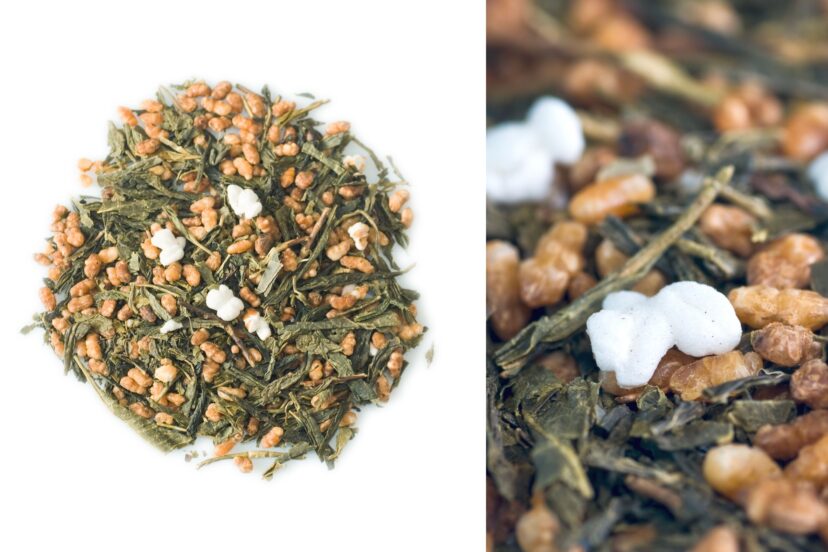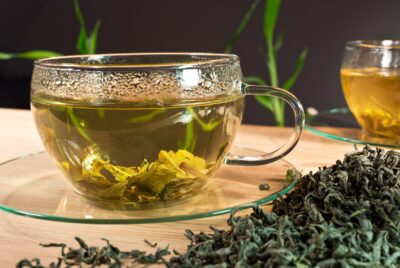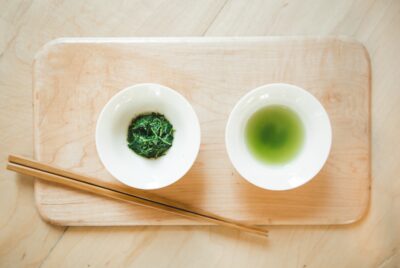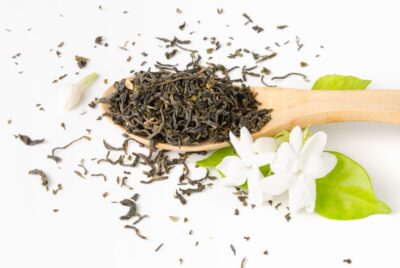Genmaicha Tea: Flavor, Health Benefits and Tradition
What is Genmaicha Tea?
Genmaicha tea, often referred to as “popcorn tea,” is a unique blend of green tea leaves and roasted brown rice. This delightful combination gives the tea a distinct, nutty flavor and a pleasant aroma that sets it apart from other types of tea.
Personal Connection to Genmaicha Tea
As a long-time tea enthusiast, I’ve always been fascinated by the diverse world of teas. Genmaicha quickly became a favorite due to its comforting taste and the rich cultural history behind it. It’s not just a beverage; it’s an experience that I love sharing with friends and family.
Health Benefits of Genmaicha Tea
Rich in Antioxidants
Genmaicha is packed with antioxidants, thanks to its green tea base. These antioxidants help combat free radicals in the body, promoting overall health and wellness.
Aids in Digestion
The roasted brown rice in Genmaicha aids in digestion, making it an excellent choice after meals. It can help soothe the stomach and promote a healthy digestive system.
Promotes Relaxation
The unique combination of green tea and roasted rice has a calming effect. Drinking Genmaicha can help reduce stress and promote relaxation, making it a perfect evening beverage.
Supports Weight Management
Genmaicha tea can aid in weight management due to the catechins present in its green tea component. Catechins are known to boost metabolism and increase fat oxidation, making it easier to manage weight. Additionally, the roasted brown rice adds a satisfying flavor, which can help curb cravings and reduce the need for sugary snacks. Regular consumption of Genmaicha, as part of a balanced diet, may contribute to weight loss and maintenance.
Enhances Mental Clarity and Focus
The green tea in Genmaicha contains L-theanine, an amino acid that promotes relaxation without drowsiness. L-theanine works synergistically with the caffeine in green tea to enhance mental clarity, focus, and cognitive function. This makes Genmaicha an excellent choice for those who need a gentle boost in concentration, whether for work, study, or creative activities.
Promotes Oral Health
Genmaicha tea contains natural fluoride and polyphenols, which can contribute to better oral health. Fluoride helps strengthen tooth enamel and prevent cavities, while the polyphenols in green tea have antibacterial properties that can reduce the growth of harmful bacteria in the mouth. Regular consumption of Genmaicha may help reduce the risk of oral infections, tooth decay, and bad breath
How Genmaicha Tea is Made
Ingredients: Green Tea and Roasted Brown Rice
Genmaicha tea is a blend of green tea leaves and roasted brown rice, creating a unique flavor profile that’s both nutty and grassy. The process of making Genmaicha involves several steps, each contributing to the tea’s distinctive taste and aroma.
Selecting the Green Tea
The green tea used in Genmaicha can vary in quality and type, with Sencha and Bancha being the most common. Sencha is made from the first or second flush of tea leaves, offering a vibrant, slightly sweet flavor. Bancha, on the other hand, is harvested later in the season, giving it a more robust and less delicate taste. Some premium versions of Genmaicha use Gyokuro, a high-grade green tea known for its rich umami flavor.
Roasting the Brown Rice
The brown rice used in Genmaicha is carefully selected and roasted until it achieves a golden-brown color. This roasting process is crucial as it imparts the characteristic nutty and toasty flavor to the tea. Some of the rice grains pop during roasting, resembling tiny popcorn kernels, which is why Genmaicha is sometimes called “popcorn tea.” The balance between popped and unpopped rice grains is important for achieving the right flavor and texture.
Blending the Tea and Rice
Once the green tea and roasted rice are prepared, they are blended together. The ratio of tea leaves to rice can vary, but a common blend is equal parts tea leaves and roasted rice. The blending process must be done carefully to ensure that the tea and rice are evenly distributed, providing a consistent flavor in every cup.
Optional Additions
Some variations of Genmaicha include the addition of Matcha, a powdered green tea. This type of Genmaicha, known as Matcha-iri Genmaicha, has a more vibrant color and a stronger, richer flavor due to the matcha. The matcha is mixed with the green tea leaves and roasted rice, adding another layer of complexity to the tea.
How to Brew the Perfect Cup of Genmaicha Tea
Equipment Needed
To brew the perfect cup of Genmaicha, you’ll need:
- A teapot or tea infuser
- Fresh, filtered water
- Genmaicha tea leaves
Step-by-Step Brewing Instructions
- Boil Water: Start by boiling fresh, filtered water.
- Measure Tea: Add one teaspoon of Genmaicha per cup into your teapot or infuser.
- Steep: Pour the hot water over the tea and let it steep for 2-3 minutes.
- Serve: Strain the tea into your cup and enjoy!
Tips for the Best Flavor
For the best flavor, use water that’s just below boiling point (around 80°C or 176°F). Avoid over-steeping, as this can make the tea bitter.
5 Types of Genmaicha Tea
1. Standard Genmaicha
Standard Genmaicha is the classic blend of green tea and roasted brown rice. It’s widely available and loved for its straightforward, nutty flavor.
2. Premium Genmaicha with Matcha
This variation includes matcha powder, which adds a vibrant green color and a richer, more intense flavor. The addition of matcha also boosts the tea’s antioxidant content.
3. Organic Genmaicha
Organic Genmaicha is made with organic green tea leaves and organic roasted brown rice. It’s a great choice for those looking to avoid pesticides and other chemicals.
4. Aged Genmaicha
Aged Genmaicha is a specialty tea where the green tea leaves used in the blend are aged for several months or even years before being combined with roasted brown rice. The aging process allows the tea leaves to develop deeper, more complex flavors, often resulting in a smoother and more mellow tea. This type of Genmaicha is less common and can be considered a delicacy, offering a richer taste experience compared to standard Genmaicha.
5. Shincha Genmaicha
Shincha Genmaicha is made using Shincha, the first harvest of green tea leaves of the season, which are prized for their freshness and vibrant flavor. When combined with roasted brown rice, Shincha Genmaicha offers a bright, lively flavor with a slightly sweet undertone. The freshness of the Shincha leaves provides a unique contrast to the toasty notes of the roasted rice, making this blend particularly refreshing and highly sought after during the spring season.
The combination of green tea and roasted rice in Genmaicha not only creates a unique taste but also makes it a versatile tea that can be enjoyed both hot and cold. The careful selection and preparation of the ingredients ensure that each cup of Genmaicha offers a delightful balance of flavors and aromas
History of Genmaicha Tea
Origin
Genmaicha tea, often referred to as the “people’s tea,” has deep roots in Japanese history and culture. The tea’s origins date back to the 15th century during the Edo period in Japan, a time when tea was a luxury that many could not afford. Genmaicha was created out of necessity, as it was made by combining green tea leaves with roasted brown rice to stretch the limited amount of tea available. This blend allowed more people, particularly the poor, to enjoy the beverage, making it an affordable alternative to pure green tea.
The name “Genmaicha” literally translates to “brown rice tea” in Japanese, reflecting its simple ingredients. The roasted rice added a toasty, nutty flavor to the green tea, creating a unique taste that quickly gained popularity beyond just the lower classes. Over time, it became appreciated across all social strata in Japan, from commoners to samurai.
Cultural Significance
Genmaicha holds a special place in Japanese tea culture. Unlike other more formal teas like matcha, which are often associated with the traditional Japanese tea ceremony, Genmaicha is seen as an everyday tea.
It is commonly consumed during meals or as a soothing drink in the evening, thanks to its lower caffeine content. The tea is also a symbol of resourcefulness and humility, reminding people of a time when nothing was wasted, and even the simplest ingredients could be turned into something enjoyable.
In modern Japan, Genmaicha is still widely consumed and loved for its unique flavor profile and its comforting, nostalgic connection to the past. It is also increasingly popular internationally, where it is celebrated not just for its taste but also for its health benefits. Whether enjoyed as a simple drink or incorporated into culinary dishes, Genmaicha remains a testament to the enduring legacy of Japanese tea culture.
This tea’s journey from humble beginnings to global recognition highlights its cultural resilience and the adaptability of Japanese traditions in the face of changing times and tastes.
Evolution Over Time
From its humble beginnings, Genmaicha has evolved significantly. Today, it is enjoyed worldwide, with variations that include premium blends mixed with matcha powder, enhancing both flavor and health benefits.
Pairing Genmaicha Tea with Food
To fully appreciate Genmaicha, try pairing it with light, savory foods that complement its nutty flavor. Avoid heavy or overly sweet dishes, as they can overpower the tea’s delicate taste.
Best Food Pairings
Genmaicha tea’s unique blend of green tea and roasted brown rice offers a nutty, slightly sweet flavor that pairs well with a variety of foods, enhancing both the tea and the meal. The tea’s mild flavor and low astringency make it a versatile companion for many dishes, particularly those with subtle or savory flavors.
Sushi and Sashimi:
The umami-rich flavors of sushi and sashimi are beautifully complemented by Genmaicha. The tea’s subtle sweetness and toasty notes harmonize with the delicate flavors of raw fish, while its light body provides a refreshing contrast to the richness of soy sauce and wasabi. The roasted rice in Genmaicha also echoes the rice used in sushi, creating a cohesive flavor experience that enhances the enjoyment of these traditional Japanese dishes.
Sushi and Seafood:
Genmaicha pairs beautifully with sushi and other seafood dishes. The tea’s umami notes complement the delicate flavors of raw fish, while its slight sweetness balances the saltiness of soy sauce. The roasted rice in Genmaicha also enhances the natural flavors of the rice used in sushi.
Rice Dishes:
Genmaicha pairs well with various rice dishes, such as plain steamed rice, rice pilaf, or even fried rice. The tea’s roasted flavor accentuates the nutty qualities of the rice, adding depth to simple dishes. Whether served alongside a light meal or as part of a more elaborate spread, Genmaicha enhances the natural flavors of rice, making it more satisfying.
Light Salads and Vegetables:
The fresh, grassy notes of Genmaicha are a great match for salads featuring ingredients like avocado, cucumber, or leafy greens. The tea’s mild astringency balances the crispness of vegetables, providing a clean, palate-cleansing experience, making it an ideal beverage to accompany raw or lightly cooked vegetables.
Grilled or Roasted Meats:
Genmaicha’s toasty flavor can add depth when paired with grilled or roasted meats, such as chicken or pork. The tea’s subtle smokiness complements the charred notes of the meat, creating a harmonious balance of flavors.
In summary, Genmaicha’s unique flavor profile makes it a versatile tea that enhances a variety of foods, particularly those with subtle or umami-rich flavors. Whether paired with sushi, sashimi, rice dishes, or salads, Genmaicha brings out the best in both the tea and the food.
Genmaicha Tea vs. Other Teas
Comparison with Green Tea
While Genmaicha is made from green tea, its flavor is quite different due to the roasted rice. Green tea is more vegetal and astringent, whereas Genmaicha is nutty and smooth.
Comparison with Matcha
Matcha is a powdered green tea with a strong, vibrant flavor. Genmaicha with matcha combines the best of both worlds, offering the rich taste of matcha with the toasty notes of roasted rice.
Comparison with Hojicha Tea
Both Genmaicha and Hojicha are Japanese green teas, but they differ significantly in flavor and processing. Hojicha is made by roasting green tea leaves, giving it a distinct, smoky flavor with a deep, reddish-brown color. In contrast, Genmaicha combines green tea with roasted brown rice, resulting in a nutty, slightly sweet taste. Hojicha is often enjoyed in the evening due to its low caffeine content, while Genmaicha, with its balanced flavor and moderate caffeine level, can be enjoyed at any time of day.
Comparison with Jasmine Tea
Genmaicha and Jasmine tea offer completely different flavor profiles and experiences. Jasmine tea is typically a green or white tea infused with the scent of jasmine flowers, giving it a floral and aromatic flavor. It’s known for its soothing and delicate taste. On the other hand, Genmaicha has a nutty and toasted flavor due to the roasted brown rice combined with green tea. While Jasmine tea is floral and light, Genmaicha is more earthy and robust, making them unique in their own right and appealing to different palates.
Unique Features of Genmaicha
The combination of green tea and roasted rice gives Genmaicha a unique flavor profile that’s both comforting and refreshing. Its low caffeine content makes it suitable for any time of day.
Choosing Quality Genmaicha Tea
Selecting high-quality Genmaicha tea ensures you enjoy the best flavor and health benefits. Here are some tips to help you choose the best Genmaicha:
Look for Bright Green Tea Leaves
Quality Genmaicha will feature bright, vibrant green tea leaves. Dull or brownish leaves can indicate old or low-quality tea. The green tea used can be sencha, bancha, or sometimes gyokuro for higher-grade blends.
Check the Roasted Rice
The roasted brown rice in Genmaicha should be evenly roasted, without being burnt. Look for a mix of both popped (which look like popcorn) and unpopped rice grains. The rice should have a consistent golden-brown color, indicating it has been properly roasted.
Aroma
A good Genmaicha should have a fresh, slightly sweet, and nutty aroma from the roasted rice. The green tea leaves should add a vegetal, grassy scent. Avoid any tea that smells stale or has a burnt odor.
Origin and Packaging
Genmaicha from reputable Japanese tea regions, such as Uji or Shizuoka, is often a mark of quality. Packaging should be airtight and opaque to protect the tea from light, air, and moisture, which can degrade its quality.
Organic Options
Opting for organic Genmaicha can be beneficial as it ensures that the tea is free from pesticides and chemicals. Organic blends might be slightly more expensive but can offer a purer tea experience.
Taste Test
If possible, taste the tea before buying. A quality Genmaicha will have a harmonious blend of the umami from green tea and the toasty flavor from the roasted rice. It should not be overly bitter or bland.
By considering these factors, you can ensure that you are purchasing high-quality Genmaicha that will provide a delightful and healthful tea experience.
Storing Genmaicha Tea
After blending, Genmaicha is typically packed in airtight containers to preserve its freshness. The tea should be stored in a cool, dark place to prevent oxidation and loss of flavor. Proper storage is essential to maintaining the tea’s quality over time.
Shelf Life
Properly stored, Genmaicha can last up to a year. However, for the best flavor, it’s recommended to consume it within six months.
Tips and Hints for Enjoying Genmaicha Tea
Enhance Flavor with Simple Additions
While Genmaicha has a delightful flavor on its own, you can enhance it with a few simple additions:
- Lemon or Citrus Zest: Adding a slice of lemon or a bit of citrus zest can brighten up the flavor.
- Honey or Agave Syrup: A touch of honey or agave can add a hint of sweetness without overpowering the tea’s natural taste.
Experiment with Water Temperature
The temperature of the water greatly affects the taste of Genmaicha. Try brewing with water at different temperatures to find your perfect cup:
- Optimal Temperature: Typically, 80°C (176°F) is ideal.
- Cooler Water: Using slightly cooler water can reduce bitterness and bring out sweeter notes.
- Hotter Water: Hotter water can enhance the roasted flavor but may also bring out more astringency.
Adjust Steeping Time
The steeping time can also alter the flavor profile:
- Short Steeping: A shorter steep of 1-2 minutes results in a lighter, more delicate flavor.
- Longer Steeping: Steeping for 3-4 minutes can bring out a stronger, more robust taste but be cautious of over-steeping, which can lead to bitterness.
Use High-Quality Water
The quality of water used in brewing tea is crucial. Use filtered or spring water for the best results:
- Avoid Tap Water: Tap water often contains chlorine and other chemicals that can negatively impact the tea’s flavor.
- Filtered Water: Using filtered water ensures a clean and pure taste.
Cold Brew for a Refreshing Twist
Genmaicha can also be enjoyed as a cold brew, which provides a refreshing and smooth flavor:
- Cold Brew Method: Add 1-2 teaspoons of Genmaicha to a pitcher of cold water. Let it steep in the refrigerator for 4-6 hours or overnight.
- Serve Over Ice: Serve the cold-brewed tea over ice for a cool and refreshing drink.
Try Different Ratios
Experiment with different ratios of tea to roasted rice to customize your Genmaicha:
- More Tea Leaves: Adding more green tea leaves can intensify the vegetal notes and caffeine content.
- More Roasted Rice: Increasing the amount of roasted rice can enhance the nutty flavor and reduce caffeine content.
Blend with Other Teas
Mixing Genmaicha with other teas can create interesting flavor combinations:
- Matcha: Adding matcha to Genmaicha (creating matcha-iri genmaicha) provides a richer, more intense flavor with added health benefits.
- Hojicha: Blending with hojicha, a roasted green tea, can enhance the roasted flavors.
Incorporate in Cooking
Genmaicha can be used in various recipes to add a unique flavor:
- Genmaicha Rice: Cook your rice with Genmaicha instead of plain water for a nutty, aromatic twist.
- Baking: Use brewed Genmaicha as a liquid ingredient in baking for an added depth of flavor in cakes, cookies, and bread.
Host a Genmaicha Tasting Party
Share the joy of Genmaicha by hosting a tasting party with friends:
- Variety of Blends: Offer different types of Genmaicha, such as organic, matcha-iri, and standard.
- Food Pairings: Provide light snacks that pair well with Genmaicha, like sushi, light salads, and grilled fish.
Genmaicha Tea for Different Occasions
Morning Routine
Start your day with a cup of Genmaicha for a gentle caffeine boost and a soothing start to your morning.
Evening Relaxation
Genmaicha’s calming properties make it an ideal evening drink. It helps you unwind and prepare for a restful night.
Social Gatherings
Serve Genmaicha at social gatherings to introduce your friends to this unique tea. Its mild flavor appeals to a wide range of tastes.
Making it a Part of Daily Routine
Incorporate Genmaicha into your daily routine for a calming ritual. Whether it’s your morning pick-me-up or your evening wind-down, Genmaicha can add a touch of tranquility to your day.
Genmaicha Tea and Sustainability
Environmental Impact
Choosing organic Genmaicha helps reduce the environmental impact of tea production. Organic farming practices promote soil health and biodiversity.
Supporting Ethical Brands
Support brands that prioritize sustainability and fair trade practices. This ensures that your tea is not only good for you but also good for the planet and the people who produce it.
Final Thoughts
Genmaicha tea is more than just a beverage; it’s a unique blend of flavor, history, and health benefits. This tea, with its origins in Japan’s Edo period, symbolizes resourcefulness and tradition. Its distinct taste, derived from green tea and roasted brown rice, offers a comforting and accessible experience for tea lovers worldwide. Whether you’re drawn to its health benefits, cultural significance, or simply its delicious flavor, Genmaicha is a tea worth exploring.
Personal Recommendation
If you haven’t tried Genmaicha yet, I highly recommend giving it a go. Its unique flavor and numerous health benefits make it a wonderful addition to any tea lover’s collection.
FAQs
What is Genmaicha Tea?
Genmaicha tea is a blend of green tea leaves and roasted brown rice, known for its nutty flavor and pleasant aroma.
Can I drink Genmaicha Tea every day?
Yes, you can drink Genmaicha tea every day. Its low caffeine content makes it suitable for regular consumption.
Is Genmaicha Tea caffeinated?
Genmaicha tea does contain some caffeine, but in lower amounts compared to other green teas and coffee.
How does Genmaicha Tea taste?
Genmaicha tea has a unique flavor that’s nutty and slightly sweet, with a mild vegetal undertone from the green tea.
Does Genmaicha Tea Have Any Side Effects?
- Genmaicha tea is generally safe for most people, but it may have some mild side effects, especially if consumed in large quantities.
- Due to its green tea content, Genmaicha contains caffeine, which can cause jitteriness, insomnia, or increased heart rate in sensitive individuals.
- The toasted rice in Genmaicha can also cause digestive discomfort for those with grain sensitivities or allergies.
- Additionally, like other green teas, Genmaicha may interact with certain medications, so it’s advisable to consult a healthcare provider if you’re taking any prescribed drugs.




